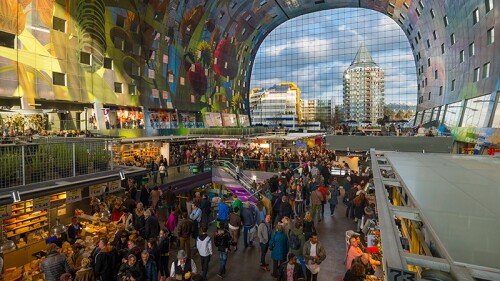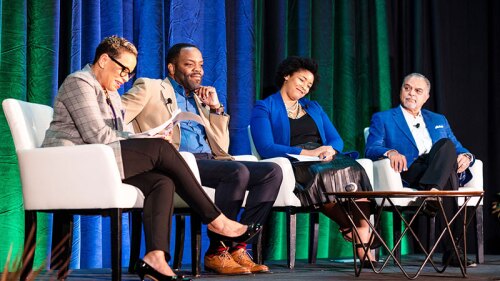In downtown Baton Rouge this summer, artists, planners, developers, and civic leaders gathered to tackle a question at the heart of the city’s future: How can arts and culture further shape Baton Rouge’s identity, economy, public spaces, and development?
Two Art in Place roundtables, hosted by the Arts Council of Greater Baton Rouge and ULI Louisiana in July 2025, set out to reimagine culture as infrastructure—not just a source of murals or festivals, but a cornerstone of downtown’s growth.
The roundtables leveraged previous work facilitated by ULI Louisiana to advance partnerships between local artists and real estate leaders in Baton Rouge. Prior efforts in 2024 included hosting two creative placemaking roundtables and a session at the statewide Louisiana Arts Summit.
The July 2025 sessions focused on embedding arts into Plan Baton Rouge III, the city’s first major downtown plan update since 2009. Led by the Baton Rouge Area Foundation and Sasaki, the plan aims to respond to today’s economy, market forces, and community priorities. The integration of roundtable recommendations into Plan Baton Rouge has the potential to position the arts to shape the city’s development, rather than be a secondary concern.
“Art shouldn’t be an afterthought,” says Gerri Hobdy, owner of Pleroma LLC. “When artists, residents, and leaders come together, they can shape the city to be full of inviting, interactive spaces that bring people together.”
A new kind of conversation
The roundtables brought together a diverse cross-section of the city: nonprofit leaders, artists, developers, planners, cultural organizers, and government officials. “The breadth and depth of experience in the room really led to great outcomes,” says Phillip LaFargue, CEO at LaFargue and facilitator of the sessions. “Arts and cultural leaders were joined by voices from construction, real estate, and design. When such a cross-disciplinary group speaks a common language, new possibilities emerge.”
The sessions emphasized social infrastructure—the networks, relationships, and institutions that allow communities to thrive. “We can never do enough to empower diverse voices,” LaFargue says. “It takes public-sector commitment to fund and support creative spaces, and it takes community members coming together. The Arts Council plays that role locally, but other institutions need to back them up.”
Luke St. John McKnight, chief operations officer of the Arts Council, noted that Baton Rouge is not alone in grappling with how to embed art in planning. “Every city falls somewhere on the spectrum of arts integration. Our job is to see what’s possible in peer cities and leverage Baton Rouge’s creativity to move forward.”
Shifting the narrative
Both LaFargue and McKnight emphasize that Baton Rouge has historically treated the arts as an afterthought, often tacked onto the end of development projects. The roundtables underscored the need to shift that paradigm.
“Developers, planners, and community members all recognized that success comes when creativity is built in from the start, not bolted on at the finish,” McKnight says. “Real estate professionals and artists may seem worlds apart, but both are engaged in creative problem-solving every day. That shared understanding is what we need to build on.”
LaFargue adds that collaboration alone isn’t enough—stakeholders need to understand the return on investment. “We need to educate councilmembers, elected officials, artists, property owners, and developers about why the arts matter,” he says. “Great ideas—about the built environment, zoning, and placemaking—won’t scale unless people see their value.”
Several clear themes emerged from the discussions:
- Art as infrastructure: Integrate artists early in planning and design, making them essential contributors rather than decorative add-ons.
- Affordable and accessible creative spaces: Repurpose vacant buildings, warehouses, and underused sites as studios, galleries, and cultural hubs that serve both community and economic purposes.
- A more comfortable downtown: Address extreme heat, limited walkability, and poor lighting with artistic shading, playful lighting, and interactive features to encourage public use.
- Building a shared community identity: Public art can unify Baton Rouge’s diverse histories and populations while reflecting the region’s ecology and culture.
- Creative placemaking as economic development: Activate spaces with performance zones, markets, festivals, and retail initiatives to drive economic growth.
- Bold and playful design: Encourage memorable, distinctive projects—a sculptural “Alligator Alley,” artist-designed swing sets, light-based murals—to give Baton Rouge a unique sense of place.
From vision to reality
Some roundtable proposals are already being visualized in renderings by WHLC Architecture, including a reimagined Shaw Center breezeway, a Main Street light installation, and a new concept for a downtown plaza with oak trees and art installations along the riverfront. Both McKnight and LaFargue noted that renderings are only first steps, though.
“Built environment dictates a place’s future,” McKnight says. “Why not want it to be beautiful?”
Developers are also stepping up. Anthony Kimble, founder and managing partner of Kimble Properties LLC, has spent the last decade revitalizing neighborhoods through affordable housing, community hubs, and adaptive reuse of historic properties such as Hotel Lincoln and the Lincoln Theater. Collaboration is central to his approach—he works with government, nonprofits, and fellow developers to ensure projects reflect community needs.
Art was central to Kimble’s vision for development at Legacy on 14th Street, a 6,200 square foot (1,890 sq m) event space and co-working development, where murals honor local figures and reflect the neighborhood’s past, present, and future. For Kimble, art isn’t just decorative. It strengthens community identity and supports broader social and economic revitalization.
Next steps
Beyond projects, the roundtables demonstrated the power of convening and trust. “When we ask, people show up,” McKnight says. “That trust allows us to achieve our outcomes.”
LaFargue added that coordinating across multiple stakeholders—property owners, developers, artists, and planners—creates confidence that recommendations will be implemented. “The true success will be if investment follows and ideas are actually built,” he says.
Roundtable recommendations will be compiled into a design brief for city and planning stakeholders, with the Arts Council leading the charge to ensure artists’ voices shape development. The final report, including visual renderings and official guidance, will be released fall 2025, amid hopes of advancing downtown Baton Rouge as a model of creative inclusion and cultural vitality.
Key recommendations include:
- Spotlight artists: Highlight local talent through media and public events.
- Develop creative spaces: Turn warehouses and underused sites into live/work hubs.
- Train artists in business: Support creative entrepreneurship and placemaking skills.
- Fund the arts: Dedicate a portion of public project budgets to regional artists through a percent-for-art program.
- Integrate art and technology: Use such flourishing tech as holograms and AI guides to boost engagement and accessibility.
- Activate underpasses: Transform spaces beneath interstates into green, art-filled public areas.
- Celebrate diversity: Commission multigenerational and multicultural works reflecting local ecology and culture.
- Foster partnerships: Encourage collaboration and mutual understanding between artists and developers.
- Measure impact: Collect local data to demonstrate the cultural and economic value of the arts.
As McKnight notes, “The ultimate goal is seeing these recommendations brought to life in the downtown plan. But another win is simply having these conversations at the right time, with the right people in the room. That’s how culture moves from the margins to the center of city-building.”








